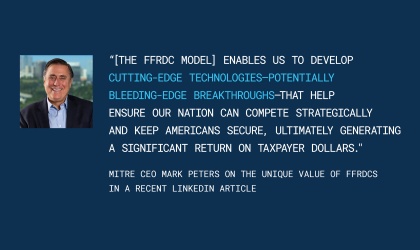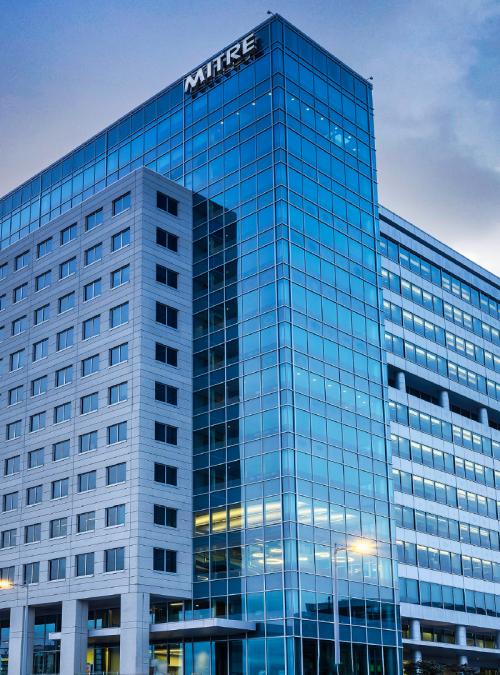
MITRE 360 April
April 2025
What is an FFRDC? In short, the not-so-short acronym stands for federally funded research and development center.
MITRE operates six of the nation's 42 FFRDCs, assisting government with long-term R&D needs. We work in the public interest free from commercial conflicts of interest.
Better together: FFRDCs tackle large-scale challenges then pass that knowledge on – to our sponsors and then to industry and academia. Our systems thinking and deep expertise complement the mission of federal agencies.
How? By advancing existing technologies and unlocking new opportunities for American enterprise to scale solutions addressing the nation's most pressing problems.
FFRDC FAQ

Q: How do FFRDCs empower U.S. tech innovation and economic growth?
When no market solution is available to a specific problem, we build prototypes for the government and share that technology with industry partners. In the last 10 years, MITRE licensed over 200 innovative technologies to more than 800 businesses nationwide, promoting economic growth for the greater good. In addition, we're on the lookout for emerging challenges (and solutions) on the horizon.
Q: Why doesn’t the government just do this work?
FFRDCs represent long-term partnerships that fill a sweet spot, often tackling problems too technically complex for the government. FFRDCs are able to build a deep bench of technical talent positioned to effectively engage with private industry.
Q: What’s the difference between an FFRDC and a government contractor?
Most federal contractors are for-profit companies that ultimately answer to their shareholders. Business motives, by their nature, can supersede objectivity. FFRDCs’ only shareholders are you, the public. By law, FFRDCs can’t manufacture products or compete with industry.
Q: What is systems-thinking?
It's a fancy way of saying we’re holistic and meticulous in how we approach complex problems. First, we zoom out to understand the big picture—the interconnectedness and interactions within a system, their dynamics, and relationships—then zoom in to solve the challenge layer by layer. It's the antidote to working in a vacuum.
Pin Drop
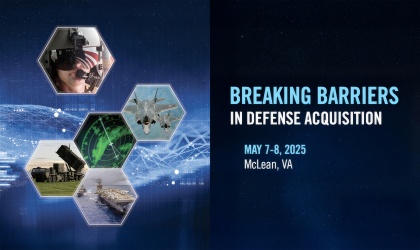
Defense Acquisition Summit at MITRE’s McLean Headquarters
Modernizing the complex defense procurement system is a challenging prospect, but a new White House Executive Order is making it a priority. On May 7-8, MITRE is hosting a summit at our McLean, Va. headquarters convening thought leaders to explore actionable solutions that will ultimately improve warfighter speed, efficiency and effectiveness. Learn more about the event: Breaking Barriers in Defense Acquisition Summit.
Why it matters: Reforms are essential to ensuring that the U.S. military can rapidly adapt to emerging threats and maintain its technological superiority on the world stage.
FFRDC SPOTLIGHT
FUSE: Boosting Warfighter Communications
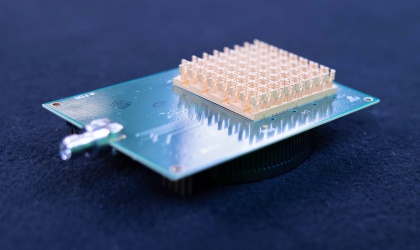
Challenge: Many emerging communication platforms serving the warfighter—on ships, satellites, aircraft, and ground systems—require more computing capacity in increasingly smaller packages. MITRE researches and develops technology with these specific considerations in mind—compact, light weight, lower power requirements, and lower cost.
Solution: In collaboration with the Naval Research Laboratory, we prototyped a new class of wideband phased array antennas called FUSE™, Frequency-scaled Ultra-wide Spectrum Element.
Impact: Because of its size, the FUSE phased array can replace multiple individual antennas, enabling multi-band and multi-function systems—including communications, radar, and electronic warfare. The novel antenna aperture design can be 3D-printed, or additively manufactured, making it more cost efficient.
From Lab to Mission—Faster: The FUSE technology was transitioned directly to our government sponsors and made available to industry through licenses, enabling them to manufacture, customize, and scale it quickly. FUSE has been licensed by 10 private companies to date.
AVIATION IMPACT
Preparing Flight Operations for Extreme Weather
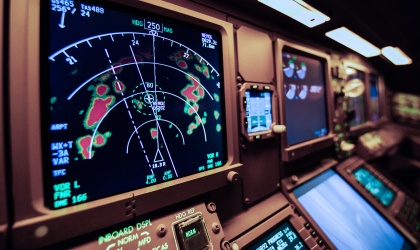
A few years ago, temperatures reached a whopping 119 degrees in Phoenix, grounding dozens of flights. (Pilots aren’t cleared to fly in temps higher than 118 degrees.) Ted Thrasher, MITRE’s lead researcher on extreme weather’s effects on aviation, called the ensuing chaos “a wake-up call for the industry.”
In addition to more frequent heat waves, heavy rain is causing flooding at airports, and severe winds and storms are contributing to greater in-flight turbulence.
Turbulence, be gone: Thrasher and his team, working in our FFRDC supporting the Federal Aviation Administration are taking a holistic, multi-pronged approach to turbulence research. Combining data from several sources, they’re finding ways to detect choppy air remotely, e.g., deploying a detector aboard the aircraft that helps pilots “see” turbulence ahead.
OUR CULTURE IN ACTION
AI Career STEMS from Love of Science

When Eliza Mace got her start working on large language models, “the barriers to entry were immense” because users had to understand the behind-the-scenes math. Now, the machine-learning engineer is embracing the “speed of change,” specifically working in MITRE’s national security FFRDC serving the Department of Defense.
A boon for intelligence analysts: "I focus on ways to use AI to help analysts do what they do even better," Mace says. "That could mean using AI to gather meaningful metrics in a massive area, say, a particular region of Earth—or developing algorithms to prioritize where an analyst looks."
EXTRA EXTRA
Mapping Cyber Threats with EMB3D
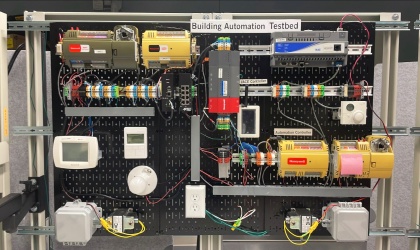
Frameworks is our middle name. We create and maintain them for a wide swath of global users to help everyone speak the same tech language. As cyber attacks on the nation’s critical infrastructure—from power grids to water treatment plants—skyrocket, it’s more important than ever that both manufacturers of devices and operators of industrial control systems (ICS) know the looming threats (hello, MITRE ATT&CK® for ICS) and understand how to best mitigate them (thank you, MITRE EMB3D™).
Dark Reading recently highlighted EMB3D, citing its effectiveness in satisfying requirements and boosting cyber security for both device manufacturers and infrastructure providers.
What is it good for? EMB3D reinforces a protected critical infrastructure ecosystem. Marie Collins, a principal working on MITRE's critical infrastructure efforts, explains: "End users can use EMB3D to better inform acquisitions, so that vendors have to clearly define a product’s security threats and associated protections."
